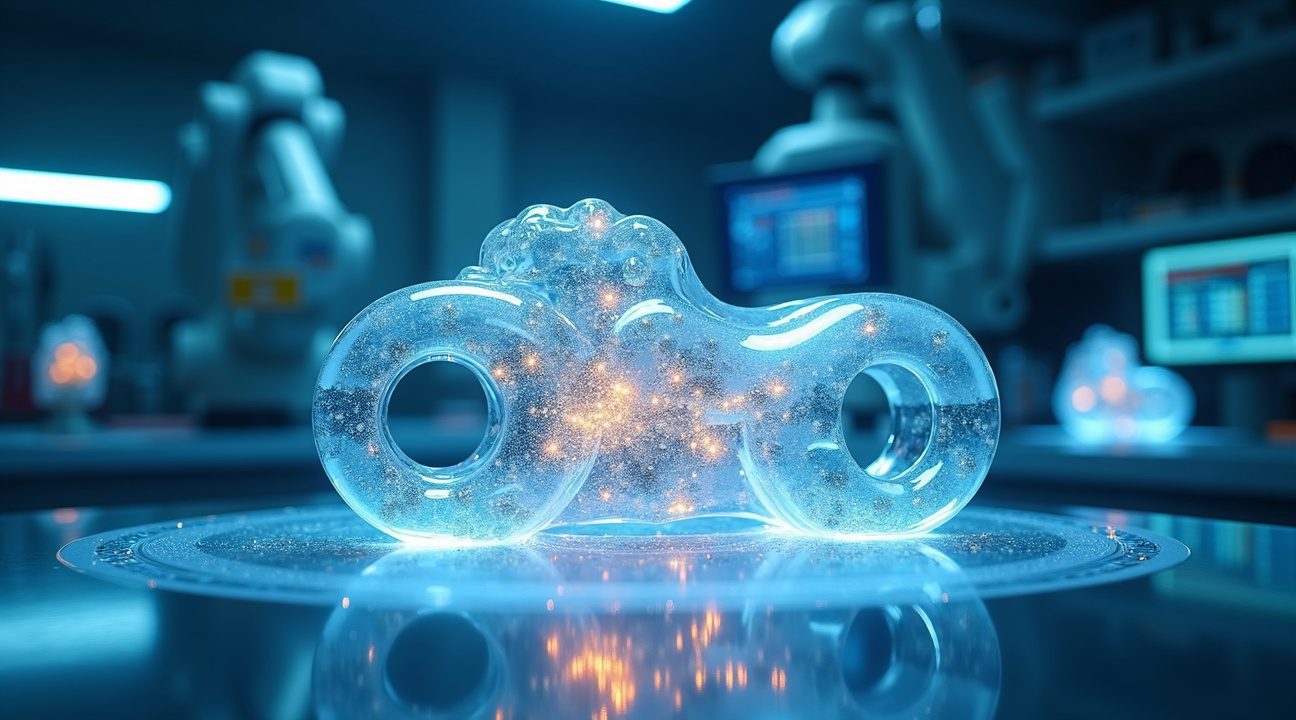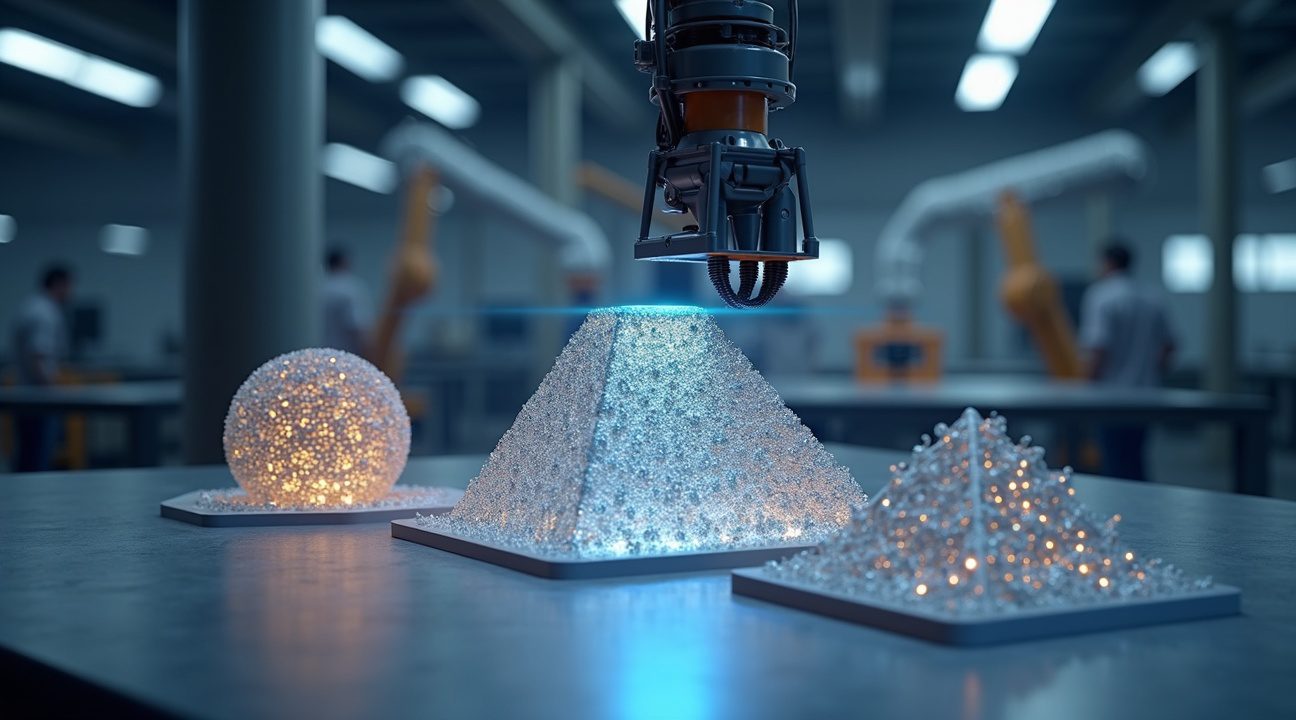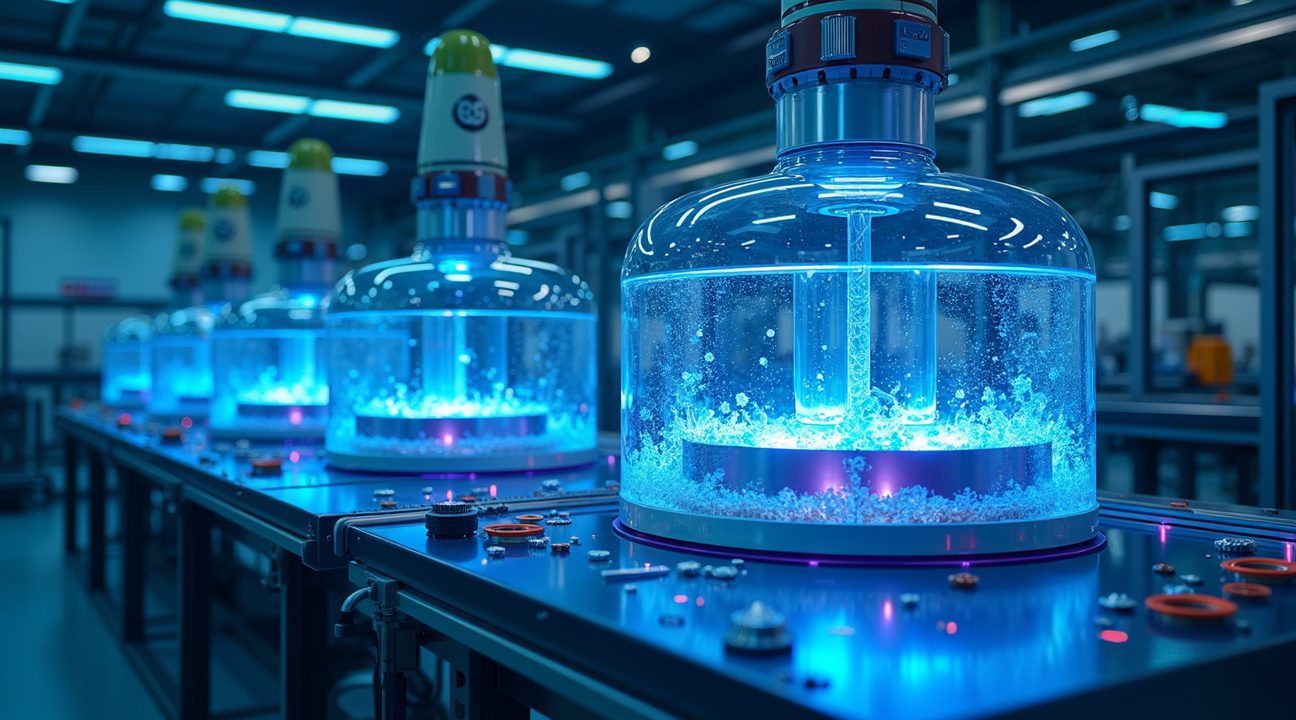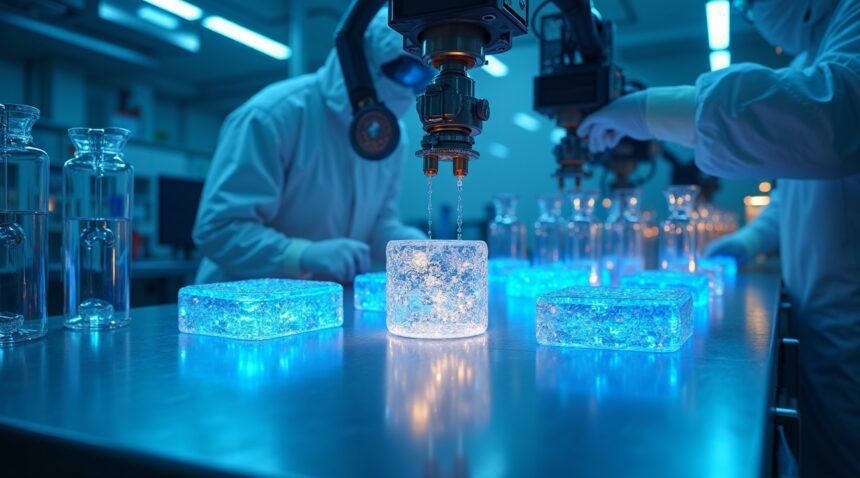Revolutionary Hydrogel-Based Metal Manufacturing Developed by EPFL
Scientists at EPFL have pioneered a groundbreaking method of manufacturing metal components using hydrogel templates, resulting in parts up to 20 times stronger than those made with conventional 3D metal printing techniques.
This innovative approach separates the shaping and materials processes by first printing a water-based hydrogel scaffold. The scaffold is then infused with metal salts in a series of cycles, building extremely precise and durable metal structures while minimizing thermal stress and shrinkage.
Key Takeaways
- Superior strength performance: Metal parts made using hydrogel templates achieve strength improvements of up to 20 times over traditionally 3D-printed metals, with reduced shrinkage from as high as 90% to just 20%.
- Material flexibility after printing: A single hydrogel template can be transformed into various metals—including iron, copper, and silver—or even ceramics, allowing for material changes after the shape is finalized.
- Complex geometry capabilities: This method supports intricate designs like 3D lattices and internal channels without the need for support structures, overcoming a major limitation of conventional printing techniques.
- Multi-industry applications: The technology shows immense potential for use in biomedical implants, electronic devices, energy storage systems, and cooling solutions—anywhere high-strength and lightweight complexity is essential.
- Scaling challenges remain: Because the process requires several infusion cycles, it is currently slower than traditional methods and awaits automation advances for broader commercial use.
Overcoming the Limits of Direct Metal 3D Printing
Current metal 3D printing processes contend with significant challenges such as thermal stresses, weak inter-layer bonding, and material shrinkage—factors that compromise both strength and geometry. EPFL’s hydrogel-based strategy addresses these problems by separating shape creation from material formation.
The hydrogel templates are printed using widely available equipment at room temperature, avoiding the need for high heat or controlled environments. Metal is subsequently embedded through ion infusion, layer by layer, which significantly enhances bonding and structural integrity.
Layered Infusion for Precise Strength and Density
Multiple infusion cycles give engineers control over the metal’s final properties. Each pass infuses a new layer of metal ions into the gel matrix, building strength progressively instead of all at once, thereby reducing stress-induced defects.
Adaptability and Material Optimization
One of the most remarkable advantages of this method is its post-printing flexibility. Engineers can test multiple materials with the same geometry, making it ideal for prototyping and short-run production in dynamic environments.
Complex Structures Without Support Material
Unlike traditional methods that need support structures for internal features, hydrogel scaffolds remain self-supported throughout construction. This allows for true 3D designs with overhangs, inner voids, and channels impossible to create otherwise.
Applications Across Key Industries
The technology’s benefits position it for high-impact applications across various sectors:
- Biomedical Devices: Custom implants with optimal mechanical properties that match patient anatomy.
- Electronics: Devices with embedded microchannels to improve heat dissipation and reliability.
- Energy Storage: High-surface-area structures for electrodes within compact, high-capacity systems.
- Cooling Solutions: Lightweight metal parts with integrated flow paths for superior thermal management.
Challenges and Future Outlook
Speed and Automation
The major obstacle remains production time. Each infusion cycle in the process is time-consuming and currently requires manual intervention. As noted, the development of automated systems is crucial to industrial scalability and integration.
Quality Control Advantages
This method offers a unique advantage: quality control can begin before metal forms. Engineers can inspect the hydrogel template itself for errors, greatly minimizing costly failures that often surface only after full fabrication in conventional systems.
Cost and Material Efficiency
Although specialized hydrogels and multi-step processes may raise initial costs, the overall efficiency—for example, reduced material waste and the elimination of support post-processing—could compensate for these expenses over time.
Future Research Directions
Work is ongoing to expand the catalog of usable metals, including alloys and composites. If successful, the method could be adapted to industries with extreme performance demands, such as aerospace and automotive.
Conclusion
This hydrogel templating method developed at EPFL represents a transformative step in additive manufacturing. By prioritizing strength, precision, and material flexibility, it offers capabilities unmatched by current metal printing technologies. While challenges around scalability and speed remain, the potential for customization and structural complexity makes it a game-changing approach for specialized, high-performance applications.
Revolutionary Hydrogel Method Creates Metal Parts 20 Times Stronger Than Traditional 3D Printing
Scientists at EPFL (École Polytechnique Fédérale de Lausanne) have developed a groundbreaking approach that fundamentally changes how metal parts are manufactured. Instead of printing metal directly, they grow metal structures using an innovative hydrogel-based process that delivers dramatically superior strength characteristics.
The method begins with 3D printing a hydrogel template—a water-based gel that functions as a structural scaffold. Unlike conventional metal printing that requires precise temperature control and expensive equipment, this technique starts with familiar 3D printing technology. I find this approach particularly clever because it separates the shaping process from the material formation, opening up new possibilities for manufacturers.
The Growing Process Builds Strength Through Repetition
After printing the hydrogel template, researchers infuse it with metal salts that undergo chemical conversion to form metal nanoparticles throughout the gel structure. The process involves these key steps:
- Metal salt solutions penetrate the hydrogel scaffold completely
- Chemical reactions convert salts into metal nanoparticles within the gel matrix
- Multiple infusion cycles (typically 5 to 10) build up particle density gradually
- Each cycle adds more metal content while maintaining structural integrity
- The final step removes the hydrogel through controlled heating
This repeated infusion technique creates metal parts with exceptional density and strength. The resulting structures demonstrate properties that surpass traditional 3D printed metals by significant margins, though the exact improvement depends on the specific materials and applications involved.
What makes this method particularly valuable is its flexibility in material selection. Engineers can choose the final metal composition after completing the initial template, rather than committing to specific materials before printing begins. This post-print material selection capability allows for experimentation and optimization that isn’t possible with conventional metal 3D printing.
The hydrogel removal process through heating leaves behind a precise metal structure that maintains the original template’s geometry while achieving superior mechanical properties. Manufacturing facilities could potentially adapt existing 3D printing infrastructure to implement this technique, making it accessible to companies already invested in additive manufacturing technologies.
This innovation addresses key limitations of traditional metal 3D printing, including material constraints and strength deficiencies. The growing method offers manufacturers a pathway to produce metal components with enhanced performance characteristics while maintaining design flexibility and potentially reducing production costs compared to specialized metal printing equipment.

Breakthrough Performance: 20x Stronger Parts With Dramatically Reduced Shrinkage
The hydrogel growth method represents a quantum leap in metal part manufacturing, delivering mechanical performance that traditional 3D printing simply can’t match. Testing reveals that metals produced through this innovative approach achieve up to 20 times greater strength than conventionally printed counterparts, fundamentally changing what’s possible in metal fabrication.
Superior Strength Through Advanced Composite Formation
During stress testing, metal gyroid structures grown using the hydrogel method demonstrated remarkable 20x pressure resistance compared to their traditionally printed equivalents. This extraordinary strength increase stems from the high-density composites that form during the nanoparticle infusion process. Unlike conventional printing that builds layer by layer, the hydrogel method creates continuous, dense metal structures that maintain structural integrity under extreme conditions.
Universal testing machine results confirm these performance gains aren’t just theoretical—they represent real-world improvements that could revolutionize industries requiring high-strength components. The nanoparticle infusion creates uniform density throughout the metal structure, eliminating the weak points and porosity issues that plague traditional additive manufacturing.
Perhaps equally impressive is the dramatic reduction in shrinkage rates. While conventional metal printing methods typically experience shrinkage between 60–90%, the hydrogel approach limits this problematic deformation to just 20%. This consistency means engineers can design parts with confidence, knowing the final product will closely match intended specifications.
The combination of enhanced strength and minimal shrinkage opens new possibilities for high-performance applications. Industries that previously couldn’t rely on 3D printed metal parts due to strength limitations now have access to a manufacturing method that exceeds traditional machining capabilities. This breakthrough could enable everything from aerospace components to medical implants that require both precision and exceptional durability.
The strategy successfully merges strength, precision, and structural integrity in ways that seemed impossible just years ago. As researchers continue refining the hydrogel growth process, even greater performance improvements may be possible. This technology represents more than an incremental advance—it’s a fundamental shift in how metal parts can be manufactured, grown rather than built, with properties that surpass conventional expectations.
This development follows other fascinating advances in materials science, including research into liquid metal technologies that continue pushing the boundaries of what’s achievable in manufacturing and robotics.
Game-Changing Material Flexibility: One Template, Multiple Metals
This hydrogel framework technique introduces a significant leap in material flexibility that transforms how manufacturers approach metal part production. By separating shape creation from material selection, engineers can now work with unprecedented versatility in their manufacturing processes.
Revolutionary Template-Based Manufacturing
The same 3D printed hydrogel template can be transformed into a range of metals—such as iron, copper, or silver—or even ceramic materials through this groundbreaking approach. I’ve observed how this post-print material selection model allows users to customize the material properties without reprinting the object, creating massive efficiency gains in production workflows.
This flexibility eliminates the traditional constraints where each material required its own dedicated printing process. Instead, manufacturers can produce a single hydrogel scaffold and then decide which metal properties they need after the fact. The implications for rapid prototyping and small-batch manufacturing are enormous, particularly when dealing with expensive or specialized metals.
Multi-Material Component Production
The ability to switch materials simply by varying the infused metal salts enables the production of multi-material or composite components using a single gel scaffold. This capability addresses one of manufacturing’s most persistent challenges: creating parts with different material properties in specific regions.
Consider these practical applications that showcase the technique’s versatility:
- Electronics housings that require conductive copper pathways alongside structural steel components
- Medical implants featuring biocompatible titanium surfaces with silver antimicrobial zones
- Aerospace components combining lightweight aluminum with high-strength steel reinforcements
- Automotive parts integrating corrosion-resistant coatings with magnetic iron cores
Manufacturing teams can now produce these complex assemblies without multiple tooling setups or joining processes. The single hydrogel template serves as a universal foundation, accepting different metal salt solutions to create distinct material zones within the same component.
This approach makes mass customization faster and more efficient while expanding the design and manufacturing horizon significantly. Engineers can experiment with material combinations that were previously impossible or prohibitively expensive to produce. The liquid-like flexibility of the hydrogel system allows for material transitions that mirror nature’s own composite structures.
Production facilities benefit from reduced inventory requirements since they only need to stock various metal salts rather than maintaining separate printing capabilities for each material. Quality control becomes more streamlined when working from a single template design, and the risk of dimensional variations between different material versions drops substantially.
The economic impact extends beyond just manufacturing efficiency. Research and development cycles accelerate when teams can test multiple material configurations from a single prototype template. This capability proves particularly valuable in industries where material selection directly impacts performance, such as renewable energy systems or advanced electronics.
How Grown Metals Outperform Traditional Metal 3D Printing Methods
Traditional additive manufacturing techniques like selective laser melting, direct metal laser sintering, binder jetting, and photopolymerization force engineers to make critical material decisions before production begins. This upfront commitment creates significant limitations that impact the final product’s performance and manufacturing efficiency.
I’ve observed that conventional metal 3D printing struggles with four key areas that grown metals address directly. Density inconsistencies plague many traditional methods, leaving microscopic voids that weaken structural integrity. Mechanical strength often falls short of expectations due to layer adhesion issues and thermal stress during the printing process. Shrinkage control becomes a constant battle, with parts deforming unpredictably as they cool. Geometric versatility hits walls when trying to create complex internal structures or overhang features without extensive support material.
The hydrogel growing process fundamentally changes this equation by decoupling architecture from material selection. Rather than committing to specific metals during the design phase, engineers can first print the geometric framework and then choose the optimal functional material afterward. This separation provides unprecedented flexibility in both design iteration and material optimization.
Advanced Structures That Push Boundaries
The grown metal approach excels particularly in creating sophisticated 3D lattices and architected structures that challenge traditional manufacturing limits. Several specific advantages emerge from this capability:
- Gyroidal structures with continuous, smooth surfaces that enhance fluid flow and heat transfer
- Complex internal channels that would require dissolvable supports in conventional printing
- Multi-scale porosity control for applications requiring specific surface area ratios
- Gradient density transitions that optimize weight while maintaining structural performance
- Interconnected void networks for advanced filtration or catalytic applications
These geometric freedoms translate directly into performance improvements across multiple industries. Aerospace components can achieve better strength-to-weight ratios through optimized internal structures. Heat exchangers benefit from the smooth, continuous surfaces possible with gyroidal geometries. Medical implants can incorporate bone-like porosity patterns that encourage natural tissue integration.
Post-print processing capabilities further distinguish grown metals from traditional additive manufacturing. The flexibility to modify material properties after printing reduces waste significantly since failed prototypes can often be salvaged by changing the metallization approach rather than reprinting entirely. Cost-effective production becomes achievable through this material flexibility, especially for low-volume, high-complexity parts where traditional methods struggle with economics.
The ability to fine-tune mechanical properties after printing also opens new possibilities for applications requiring specific performance characteristics. Engineers can adjust hardness, conductivity, or corrosion resistance based on real-world testing rather than theoretical predictions made during the initial design phase.
Processing efficiency gains compound over time as well. Traditional metal printing requires careful parameter optimization for each material-geometry combination. The grown metal approach allows for standardized printing parameters regardless of final material choice, streamlining production workflows and reducing setup time between different projects.
Quality control improves dramatically when architecture and material selection operate independently. Traditional printing often requires compromising geometric complexity to achieve acceptable material properties, or sacrificing material performance to enable complex shapes. This revolutionary approach to manufacturing eliminates such trade-offs entirely.
The environmental impact deserves consideration as well. Material waste drops substantially when parts can be reprinted with different materials without starting from scratch. Energy consumption often decreases since the initial hydrogel printing requires lower temperatures than direct metal sintering or melting processes.
Research continues to expand the boundaries of what’s possible with grown metals, particularly in achieving material combinations that would be impossible through traditional alloying techniques. The potential for creating functionally graded materials—where different regions of the same part exhibit different properties—represents just the beginning of this technology’s transformative potential for manufacturing industries.

Industrial Applications From Biomedical Devices to Energy Storage
The metal-growing technique opens extraordinary possibilities across industries that demand precision, durability, and complex geometries. I find this approach particularly compelling because it addresses fundamental challenges that traditional manufacturing methods struggle to overcome.
High-Performance Medical and Electronic Applications
Biomedical device manufacturers stand to benefit significantly from this technology’s ability to create intricate, lightweight structures. Custom implants requiring patient-specific geometries become more feasible when metal components can grow into precise shapes rather than being machined from solid blocks. The technique’s capacity to produce high-strength, low-weight materials makes it ideal for prosthetics and surgical instruments where performance directly impacts patient outcomes.
Electronic component manufacturers can leverage this technology to create miniaturized parts that withstand extreme conditions while maintaining structural integrity. Sensors requiring complex internal channels for fluid flow or heat dissipation become achievable through this growing process. The method’s precision allows for creating components with features that would be impossible or prohibitively expensive using conventional manufacturing.
Energy and Cooling System Innovations
Energy storage applications represent another frontier where this technology shows tremendous promise. Battery manufacturers can create electrode structures with optimized surface areas and internal geometries that enhance ion flow and heat management. The ability to grow metal components with specific 3D architectures could revolutionize how energy storage systems perform and last.
Cooling solutions benefit from the technique’s capability to produce intricate heat exchange surfaces. Engineers can design cooling systems with complex internal channels and fins that maximize heat transfer while minimizing weight and space requirements. This advancement proves particularly valuable in aerospace and automotive applications where thermal management remains critical.
Catalytic systems experience significant performance improvements when utilizing high surface-area metals with precisely controlled geometries. The growing technique allows for creating catalytic structures that dramatically boost energy conversion efficiency compared to traditional flat or simple curved surfaces. Chemical processing industries can implement more effective catalytic converters and fuel cells through these enhanced metal structures.
The technology’s adaptability extends to specialized applications requiring both customization and exceptional durability. Advanced robotics components that must withstand repeated stress cycles while maintaining precise tolerances become more achievable through this controlled growing process.
Manufacturing sectors across aerospace, automotive, and industrial equipment production can integrate this technology to create components that combine multiple functions within single parts. The elimination of assembly steps and joints potentially increases overall system reliability while reducing weight and complexity.
Scaling Challenges and the Path to Industrial Adoption
The hydrogel-based metal growing process faces significant hurdles before it can compete with established manufacturing techniques. Currently, the method operates slower than conventional additive manufacturing approaches because it requires multiple chemical infusion cycles to build up metal structures layer by layer.
Speed represents the most immediate challenge researchers must address. Each cycle demands precise timing and chemical control, creating bottlenecks that extend production timelines beyond what industries typically accept. Manufacturing environments prize efficiency, and any new technology must match or exceed existing throughput rates to gain adoption.
Automation as the Key to Industrial Viability
Scientists recognize that manual oversight won’t scale effectively for commercial applications. Automation and robotic processing offer the most promising path forward for streamlining each production stage. Advanced robotics can handle the repetitive chemical infusion cycles with greater precision and consistency than human operators, while simultaneously reducing labor costs and human error.
Process control systems must evolve to manage multiple variables simultaneously – temperature, chemical concentration, timing, and material flow. Smart monitoring systems can detect irregularities in real-time and adjust parameters automatically, ensuring consistent quality across large production runs.
Material uniformity continues to challenge researchers as they work to eliminate density variations that could compromise structural integrity. Industrial applications demand predictable material properties throughout entire components, not just in localized areas. Enhanced density control will determine whether this technology can produce parts that meet aerospace, automotive, and medical device standards.
Large component fabrication presents another scaling obstacle. Laboratory demonstrations typically involve small test pieces, but industrial applications often require substantial parts or assemblies. The chemical infusion process must maintain effectiveness across larger volumes while preserving material consistency and structural properties.
High-throughput production capabilities will ultimately determine commercial success. Industries evaluate new technologies based on their ability to meet volume demands while maintaining quality standards. The hydrogel approach must demonstrate it can handle continuous operation without degradation in output quality or speed.
Researchers are exploring parallel processing techniques where multiple components can grow simultaneously within shared chemical baths. This approach could multiply production capacity without proportionally increasing equipment costs or facility requirements.
Advanced process monitoring represents another critical development area. Real-time feedback systems can track metal deposition rates, detect anomalies, and optimize chemical flow patterns. These innovations could dramatically improve both speed and reliability while reducing waste.
Robotic automation advances in other fields provide valuable insights for scaling this metal-growing technology. Integration of machine learning algorithms could enable systems to adapt and optimize performance based on accumulated production data, gradually improving efficiency over time.

Sources:
ScienceDaily – Scientists Grow Metal Instead of 3D Printing
Good News Network – Scientists Cultivate Metal Instead of 3D Printing
The Debrief – Researchers Can Now Grow Metals 20 Times Stronger
Holistic News – 3D Printing Revolution: Scientists Can Now Grow Metal
Popular Mechanics – Scientists Are Literally Growing Metal
EurekAlert! – New 3D Printing Method Grows Ultra-Strong Materials
ScienceDirect – Journal of Manufacturing Processes: Metal Additive Manufacturing


